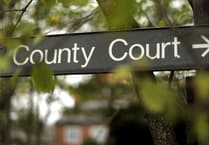EACH week, hundreds of planning applications come before Cornwall Council’s planning department, seeking to win approval for various plans right across the Duchy, with some concerning Holsworthy handled by Torridge District Council.
These plans can comprise of a number of different reasonings– ranging from permission to replace windows or listed building consent ranging up to large house building developments or changing of use of a building, for instance, from an office to a café, or flats.
Within this large and often complex system, there are a number of formats from which planning advice and approval can be sought.
These range from full applications where all the details which comprise a proposed development or work to a building are submitted, to outline applications, where further details are yet to be confirmed, for example, an outline application with reserved matters for appearance may not confirm the final proposed development but rather seek permission in principle.
An example of this is one for an outline permission for 20 dwellings on land with reserved matters for appearance and scale; the reserved matters would require further permission later for their inclusion.
Other types of applications include pre-application advice requests, where would-be developers submit often outline proposals to a local authority to ascertain whether it is likely to gain support or not prior to submitting a planning application.
The vast majority of applications are decided by planning officers employed by a local authority under ‘delegated powers’, meaning they do so on behalf of their employer, however, some applications are ‘called in’ by local councillors to be discussed at an area’s strategic planning committee meeting, meaning the final decision rests with a committee of councillors.
PA24/00037/PREAPP: PROPOSALS for the demolition of an existing dwelling and the construction of five dwellings and associated works at a property in Poughill has been met with an unfavourable response by Cornwall Council.
Mr T Swift sent a ‘pre-application advice’ request to the local authority to enquire whether his plans for the demolition of one property and the construction of five properties at Rambridge, Stone Hill, Poughill, Bude would be likely to win officer approval.
The location of the development is described as: “Located in an elevated rural location on land adjacent to the Wooda Holiday Park Complex comprising an existing large dwelling, to the east of Poughill. The site is in part residential, and part general agriculture use/pasture, prominent in the immediate vicinity, with far reaching views.
“Aerial imagery shows a number of polytunnel type structures stand on the land.”
In their response, Mr Swift was told by the planning officer that support was unlikely to be obtained in its current format, owing to various concerns over the location of the proposed development and the proposed design.
They wrote: “In my considered opinion the proposal as outlined, based on the information provided and local and national planning policy context is unlikely to be supported. The location of the proposed residential development would not accord with the strategy for housing development as set out in the development plan, the scale and design of the proposal layout is incongruous in the setting.
“The proposal would not significantly enhance its immediate setting or be sensitive to the defining characteristics of the local area; and the proposal would cause harm to the character and appearance of the area. The proposal is considered to be substantially reliant on private vehicles for transport.
“Overall, the scheme would not comply with the development plan when considered as a whole and there are no material considerations that outweigh the identified harm and associated development plan conflict.
“Please note that any advice given by Council officers for pre-application enquiries does not indicate a formal decision by the Council as local planning authority. Any views or opinions expressed are given in good faith, and to the best of ability, without prejudice to the formal consideration of any planning application following statutory public consultation, the issues raised and an evaluation of all available information.
“You should note that this letter does not constitute a formal decision by the Council (as local planning authority). It is only an officer’s opinion given in good faith, and without prejudice to the formal consideration of any planning application.”
PA22/07517: PROPOSALS for the phased development of three dwellings, together with associated works for land near Bude has been refused by Cornwall Council’s planning department.
S Hansen applied to the local authority for permission to build the three dwellings on land south of Trelowarth, Cleavelands, Bude. The plans, however, were met with objections.
Among those objections registered with Cornwall Council’s planning department was one from Bude-Stratton Town Council, whose planning committee are a statutory consultee.
In their response to the application, the town council said: “BSTC object to the application. The site is of significant historical, cultural and natural value and should be preserved as is. The application doesn’t demonstrate a reasonable balance of harm against delivery of value to the community and loss of the site would in fact be a significant detriment of the amenity to our community.”
Historic England also objected to the proposal, stating: “Binhamy moat is a designated Scheduled Monument and, as such, is considered to be of national importance. The moated site is thought to be the site of ‘Bynnamy’ or ‘Binamy Castle’, built in around 1335 by Ralph de Blanchminster, Lord of the Manor of Stratton, who had been granted a license to castellate his Page 3 of 13 mansion at Binhamy. It was later spoken of as the seat of Sir J Colshill by William Worcester and subsequently described as ‘Ruyned aunient seate of the Grenviles’ by Norden in around 1600.
“Borlase identified it as a Roman camp in around 1750 but by 1814 Lysons, and later Gilbert (1820), identified it as the mansion house of the Blanchminsters. In use as an orchard by 1750 it remained so until the late 19th century. Moated sites become more unusual as you head south west and are rare in Cornwall, there being but a handful recorded and only one other Scheduled in the Duchy.
“The moated site at Binhamy survives comparatively well and contains archaeological and environmental evidence relating to its construction, longevity, social organisation, domestic arrangements, re-use, abandonment and overall landscape context. The site, which formerly sat in open fields on the outskirts of Bude/Stratton, is now almost surrounded by modern development up to the 50m buffer zone, maintaining a modest margin as a buffer zone in which to preserve some small element of the monuments rural character and setting. This is of importance because the moat, which has recently been shown through geophysical survey to contain the remains of a substantial range of buildings, represented a significant statement of importance in a rural landscape in which moated sites were rare. The application would result in the loss of what is, effectively, a buffer margin, provided by the grounds of Trelowarren and would introduce development into a side of the monument with a smaller margin than that to the east and would result in a significant impact on the setting and significance of the Scheduled Monument. Under the NPPF it is a core planning principle to conserve heritage assets in a manner appropriate to their significance, so that they can be enjoyed for their contribution to the quality of life of this and future generations. When considering the impact of a proposed development on the significance of a designated heritage asset, great weight should be given to the asset’s conservation.
“If a proposal cannot be amended to avoid all harm, then if the proposal would lead to less than substantial harm to the significance of a designated heritage asset, this harm should be weighed against the public benefits of the proposal, including securing its optimum viable use .
“Where a proposed development would lead to substantial harm to or total loss of significance, local planning Page 4 of 13 authorities should refuse consent, unless it can be demonstrated that the substantial harm or loss is necessary to achieve substantial public benefits that outweigh that harm or loss, or all of the tests in paragraph 200 of the NPPF apply. It should be noted that less than substantial harm is still harm.
“Historic England objects to the application on heritage grounds. We consider that the application does not meet the requirements of the NPPF, in particular paragraph numbers 197, 199, 200, and 202.
“Your authority should take these representations into account in determining the application. If you propose to determine the application in its current form, please inform us of the date of the committee and send us a copy of your report at the earliest opportunity.”
Refusing the application, Cornwall Council said: “The proposal, by reason of its siting and proximity to the Binhamy moated site; a designated Scheduled Ancient Monument (SM) on the Heritage at Risk Register, would introduce further new development into a small remaining margin of open space buffering the SM and would result in a harmful encroachment upon the heritage asset and its setting. The degree of harm arising from the proposed development amounts to less than substantial harm. The benefits of the proposal do not outweigh the identified harm and the application is therefore not sustainable development.
Furthermore, in the absence of an adequate geophysical survey to determine the impacts of the proposed development on buried archaeological remains, it has not been possible to determine the extent and acceptability of the proposed impacts.




